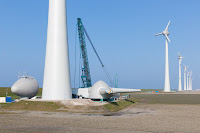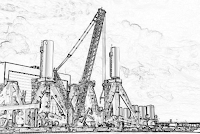In
more than 25 years we have carried out a number of projects in the
offshore industry and have developed special UHPC systems for many of
our current customers.
The future for us started a few years ago in
UHPC development, in terms of UHPC material development for floating
offshore power generation, floating city constructions and coastal
protection. The UHPC materials are ready for use today. These materials
are far superior to all other materials.
MonopilePreviously used material: UHPC
UHPC is used since the year 2000 in the new transition piece
(more than 200,000 tons have been installed so far).
Other possible uses: Tower construction, corrosion protection in the underwater
area, Increase in stability, expansion of a foundation part for
sustainable species protection
UHPC properties: High compressive and tensile strength, fast curing, very good
pumpability, curing under water, very good corrosion
protection, ductile properties, absolutely sea water resistant
Processing: On site at sea - Transition piece
On land - Tower elements as prefabricated parts - assembly
of the prefabricated parts partly on land, partly at sea
Tripot
Previously used material: UHPC
UHPC is used since the year 2000 in the new transition
piece (more than 200,000 tons have been installed so far).
Other possible uses: Corrosion protection in underwater areas, increase in
stability, expansion of a foundation part for sustainable
species protection
UHPC properties: High compressive and tensile strength, fast curing, very
good pumpability, curing under water, very good
corrosion protection, ductile properties, absolutely
seawater resistant
Processing: On site at sea
 Offshore
Offshore
Previously used material: UHPC
UHPC is used since the year 2000 for repairs of structures
Other possible uses:
Platform construction, platform structures, corrosion
protection in the underwater area, increasing the static
load-bearing capacity
UHPC properties:
High compressive and tensile strength, fast curing, very
good pumpability, curing under water, very good
corrosion protection, temperature resistance up to
1200°C, ice-resistant, absolutely seawater-resistant,
waterproof after a layer thickness of a few millimeters
Processing:
On site at sea
On land: - Production of precast elements
Jetty
Previously used material is concrete, steel or UHPC
UHPC has been used since the year 2000 to repair the
supports and the deck
Other possible uses:
Complete jetty constructions, repair of existing jetties,
improvement of the load-bearing capacity of the jetties,
significant extension of the operating time compared to
wood, concrete and steel
UHPC properties:
High compressive and tensile strength, fast curing,
very good pumpability, curing under water, very good
corrosion protection, weight reduction compared to
concrete or steel, absolutely seawater resistant,
waterproof after a layer thickness of a few millimeters
Processing:
On site at sea and on land

Floating Offshore
Previously used material is steel and anti-corrosion paint
systems
Other possible uses:
Platform construction, platform structures, corrosion
protection in the underwater area, increasing the static
load-bearing capacity
UHPC properties:
High compressive and tensile strength, fast curing,
very good pumpability, curing under water, very
good corrosion protection, temperature resistance
up to 1200°C, ice-resistant, absolutely
seawater-resistant, waterproof after a layer
thickness of a few millimeters
Processing:
On site at sea
On land - Production of precast elements
Floating Windmill
Material used so far is steel and concrete
Other possible uses:
Floating construction, tower construction, corrosion
protection in underwater areas, increasing the static
load-bearing capacity
UHPC properties:
High compressive and tensile strength, fast curing,
very good pumpability, curing under water, very
good corrosion protection, ice-resistant, absolutely
seawater-resistant, waterproof after a layer thickness
of a few millimeters
Processing:
On site at sea for repair or in dry dock
Barge
Previously used material is steel or UHPC
UHPC is used since 2002 as a new barge constructions
Other possible uses: Ship hulls, houseboats, pontoons, working platforms
UHPC properties: High compressive and tensile strength, fast curing, very
good pumpability, curing under water, very good
corrosion protection, very good wear protection,
absolutely seawater-resistant, good ductility,
processing as shotcrete or casting compound possible,
Waterproof after a layer thickness of a few millimeters
Processing: On land
Floating dock
Previously used material is steel or UHPC
UHPC was used in the year 2018 for the construction
of a new floating dock.
Other possible uses:
Ship hulls, houseboats, pontoons, work platforms
UHPC properties:
High compressive and tensile strength, fast curing,
very good pumpability, curing under water, very
good corrosion protection, very good wear protection,
absolutely seawater-resistant, good ductility,
processing as shotcrete or casting compound possible,
Waterproof after a layer thickness of a few millimeters
Processing:
At shore in the dock
Flood protection erosion
Previously used material is concrete
UHPC could be used as an alternative to concrete in
dike and bank protection.
UHPC properties: High compressive and tensile strength, fast curing,
very good pumpability, curing under water, very
good corrosion protection, very good wear protection,
absolutely seawater-resistant, processing as shotcrete
or casting compound possible
Processing: On land as precast concrete parts or mats in all sizes,
structures and shapes.
Cliff protection Previously used material is concrete or other materials
UHPC could be used as an alternative to concrete or other
materials.
UHPC properties: High compressive and tensile strength, fast curing, very
good pumpability, curing under water, very good corrosion
protection, very good wear protection, absolutely
seawater-resistant, processing as shotcrete or casting
compound possible
Processing: On land as precast concrete parts or as shotcrete directly
on site
Reef protection Previously used material is concrete or other materials
UHPC could be used as an alternative to concrete or other
materials.
UHPC properties: High compressive and tensile strength, fast curing, very
good pumpability, curing under water, very good corrosion
protection, very good wear protection, absolutely
seawater-resistant, processing as shotcrete or casting
compound possible
Processing: On land as precast concrete parts or as casting compound
directly on site
Flood gate Previously used material is steel
UHPC will be used in the year 2021 as an replacement for
steel structures
UHPC properties: High compressive and tensile strength, fast curing, very good
pumpability, curing underwater, very good corrosion protection,
ice-resistant, absolutely seawater-resistant, waterproof after a
layer thickness of a few millimeters
Processing on land: Production of precast elements
Underwater living areas Previously used material is concrete
UHPC properties: High compressive and tensile strength, fast curing, very good
pumpability, curing under water, very good corrosion protection,
temperature resistance up to 1200°C, ice-resistant, absolutely
seawater-resistant, waterproof after a layer thickness of a few
millimeters
Processing on land: Production of precast elements or complete construction
Pontoon, Caisson Previously used material is concrete
UHPC properties: High compressive and tensile strength, fast curing, very good
pumpability, curing under water, very good corrosion protection,
temperature resistance up to 1200°C, ice-resistant, absolutely
seawater-resistant, waterproof after a layer thickness of a few
millimeters
Processing: On site at sea
On land - Manufacture of complete constructions
Protection mesh sub sea pipeline Previously used material is concrete
UHPC properties: High compressive and tensile strength, fast curing, very
good pumpability, curing under water, very good corrosion
protection, absolutely seawater resistant
Processing: On site at sea
On land - Production of precast elements
Protection mesh sub sea cable Previously used material is concrete
UHPC properties: High compressive and tensile strength, fast curing, very
good pumpability, curing under water, very good corrosion
protection, ice-resistant, absolutely seawater-resistant
Processing: On site at sea
On land - Production of precast elements
Energy spherical pressure accumulator systems Deep sea pressure storage systems for offshore wind turbines
Previously used material is concrete
UHPC properties: High compressive and tensile strength, fast curing, very good
pumpability, curing under water, very good corrosion protection,
temperature resistance up to 1200°C, ice-resistant, absolutely
seawater-resistant, waterproof after a layer thickness of a few
millimeters
Processing: On site at sea
On land - Manufacture of prefabricated structures
Offshore LNG storage Floating platforms as quays, gas or oil interim storage
facilities and processing centers
Material used so far is steel and concrete
UHPC properties: High compressive and tensile strength, fast curing, very good
pumpability, curing under water, very good corrosion
protection, temperature resistance up to 1200°C, ice-resistant,
absolutely seawater-resistant, waterproof after a layer
thickness of a few millimeters
Processing: On site at sea
On land - Production of precast elements
Offshore rocket launch site systems
The launch systems such as small and medium-sized rockets for
the transport of satellite systems can be provided on ship
systems or floating platform systems.
UHPC properties:
High compressive and tensile strength, fast
curing, very good pumpability, curing under water, very good
corrosion protection, temperature resistance up to 1200°C,
ice-resistant, absolutely seawater-resistant, waterproof after a
layer thickness of a few millimeters
Processing:
On site at sea
On land - Production of precast elements
Floating city
Development of floating platforms for living and working with
independent energy generation. In coastal areas and estuaries.
The platforms can also be provided with port facilities and runways.
Platform construction, platform structures, corrosion protection
in the underwater area, increasing the static load-bearing capacity
UHPC properties: High compressive and tensile strength, fast curing, very good
pumpability, curing under water, very good corrosion
protection, temperature resistance up to 1200°C, ice-resistant,
absolutely seawater-resistant, waterproof after a layer thickness
of a few millimeters
Processing: On site at sea
On land - Production of precast elements
Floating underwater tunnel tubes
Other possible uses:
Platform construction, platform structures, corrosion protection in
the underwater area, increasing the static load-bearing capacity
UHPC properties:
High compressive and tensile strength, fast curing, very good
pumpability, curing under water, very good corrosion protection,
temperature resistance up to 1200°C, ice-resistant, absolutely
seawater-resistant, waterproof after a layer thickness of a few
millimeters
Processing:
On site at sea
On land: Production of precast elements
Deep sea constuction
UHPC was tested in the year 2018 under water pressure conditions
from 3000 meters deep for the compressive strength of a test
construction. The test turned out positive
Possible uses:
Constructions for the deep sea, residential constructions, working
constructions, military
UHPC properties:
Very high compressive and tensile strength, fast curing, very good
pumpability, curing under water, very good corrosion protection,
very good wear protection, absolutely seawater-resistant, good
ductility, processing as shotcrete or casting compound possible
Processing:
On land
WPE DK International
Phone: 0049 176 601 73146
E-mail: info@wpe-dk.dk
Homepage: www.wpe-dk.com
 In more and more parts of the world, the availability of sand is becoming increasingly difficult or even impossible for the construction industry.
In more and more parts of the world, the availability of sand is becoming increasingly difficult or even impossible for the construction industry.











































